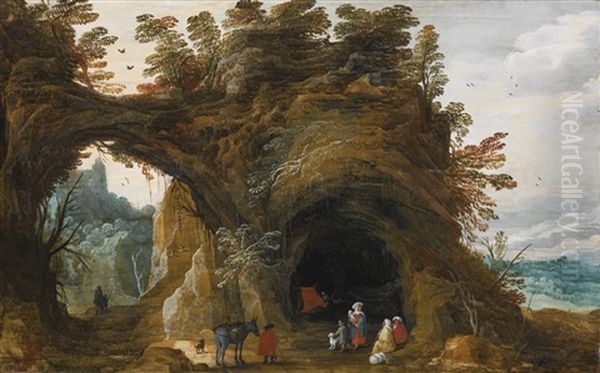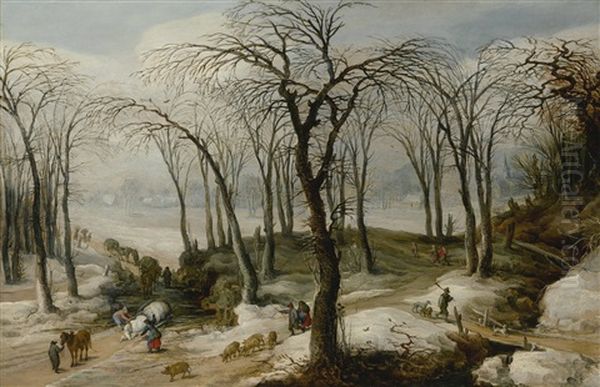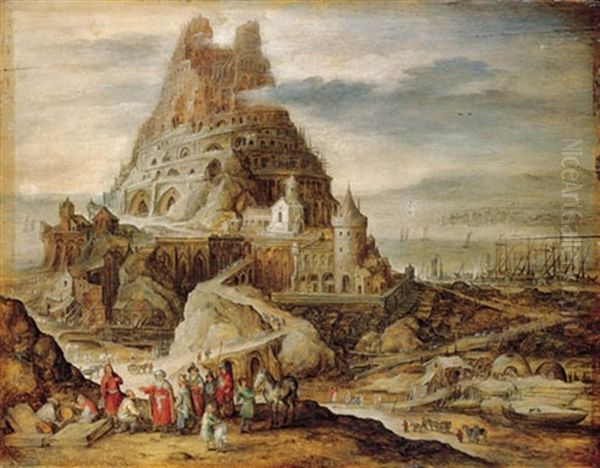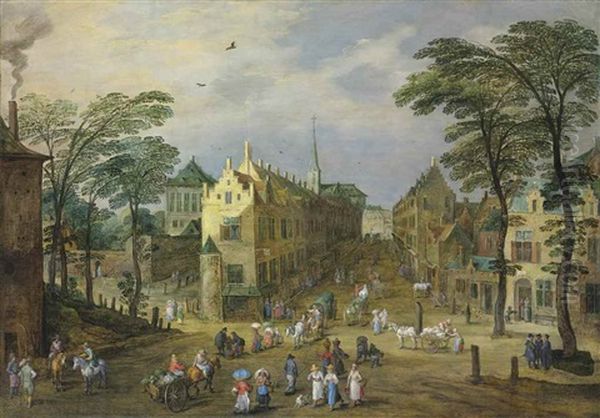Joos de Momper the Younger stands as a pivotal figure in the rich tapestry of Flemish art history. Active during the late 16th and early 17th centuries, he was a prolific and highly influential landscape painter based in Antwerp. His work forms a crucial bridge between the imaginative, stylized world of late Mannerism and the burgeoning realism of the Baroque era, particularly within the specialized genre of landscape painting. Born into an artistic dynasty, Momper carved out a distinct niche, becoming renowned for his often dramatic and panoramic depictions of mountainous terrains, river valleys, and winter scenes.
An Artistic Heritage: Early Life and Training in Antwerp
Joos de Momper the Younger was born in Antwerp around 1564, into a family already established in the city's vibrant artistic community. His grandfather, Joos de Momper the Elder, was a painter, and his father, Bartholomeus de Momper, was not only a painter but also an art dealer and print publisher. This familial environment undoubtedly provided the young Joos with early exposure to the techniques and business of art. His mother was Susanna Halfroose.
He received his primary artistic training from his father, Bartholomeus. Immersed in the craft from a young age, Joos quickly developed his skills. By 1581, at the relatively young age of 17, he was formally enrolled as a master in the prestigious Antwerp Guild of Saint Luke. This membership marked his official entry into the professional art world of a city that was then a major European center for arts and commerce. His early acceptance into the guild speaks to his precocious talent and the solid training he received within his family's workshop.
The Call of the South: The Italian Influence
While concrete documentary proof remains elusive for some periods of his life, strong evidence suggests that Joos de Momper traveled to Italy sometime during the 1580s, likely after becoming a master in the Guild. This journey south was a common practice for ambitious Northern European artists seeking to study classical antiquity and the masterpieces of the Italian Renaissance. His exposure to the Alps during this presumed trip is often cited as a direct inspiration for the dramatic, often fantastical mountain landscapes that became his hallmark.

Further evidence supporting an Italian sojourn includes landscape frescoes in the church of San Vitale in Rome. These works, depicting scenes from the life of Saint Vitalis, were historically attributed to the prominent Flemish painter Paul Bril, who was active in Rome. However, stylistic analysis has led many modern scholars to attribute these frescoes to Joos de Momper, suggesting he spent time working in the city. This Italian experience would have broadened his artistic horizons, exposing him to different approaches to light, color, and composition, even as he retained a distinctly Flemish character in his work.
Evolving Vistas: Artistic Style and Development
Joos de Momper's extensive body of work showcases a fascinating evolution in landscape painting. His early works often lean towards the Mannerist tradition, characterized by dramatic, somewhat artificial compositions, high viewpoints offering panoramic vistas, and stylized, craggy rock formations. These paintings frequently possess a fantastical quality, depicting imaginary mountain ranges rather than specific, identifiable locations. This approach aligns with the "world landscape" tradition pioneered by earlier Flemish masters like Joachim Patinir.
Over time, particularly into the 17th century, Momper's style gradually incorporated elements of greater naturalism, reflecting the broader shift towards the Baroque. While still favoring dramatic mountain scenes, his later works often display a more convincing sense of atmospheric perspective, a subtler handling of light and shadow, and a more unified composition. He frequently employed a conventional three-color scheme to create depth: warm browns and ochres in the foreground, transitioning to greens in the middle distance, and finally blues and greys for the distant background and sky.
His brushwork was typically fluid and confident, sometimes quite painterly and anticipating later developments. He could define forms with energetic strokes and small dabs of paint, particularly in rendering foliage and rocky textures. Despite the move towards realism, a sense of imagination and drama remained central to his appeal. He was heavily influenced by the work of Pieter Bruegel the Elder, especially in his adoption of high viewpoints and his interest in depicting seasonal changes, most notably winter landscapes.
Masters in Concert: A Culture of Collaboration
Collaboration between specialist painters was a hallmark of Antwerp's art production in the 17th century, and Joos de Momper was a frequent participant in such partnerships. While he was a master of landscape, he often relied on other artists to paint the figures (staffage) that populated his scenes. This practice allowed each artist to focus on their area of expertise, resulting in high-quality, marketable works produced efficiently.

His most significant and frequent collaborator was Jan Brueghel the Elder, son of Pieter Bruegel the Elder and a renowned master of detailed floral still lifes and small-scale figures. Their joint works are numerous and highly prized. Jan Brueghel would meticulously paint figures, animals, and sometimes even foreground elements into Momper's expansive landscapes. Examples like A Hermit Before a Grotto (1616) or scenes depicting markets and bleaching fields showcase this seamless integration of talents. The detailed, jewel-like figures by Brueghel provide narrative focus and scale within Momper's often vast settings.
Momper also collaborated with other prominent Antwerp figure painters. Frans Francken the Younger, known for his elegant figures in historical and allegorical scenes, frequently added staffage to Momper's landscapes. Hendrick van Balen, another specialist in mythological and religious figures, also worked with Momper. Sebastiaen Vrancx, primarily known for battle scenes and genre subjects, is also believed to have contributed figures to some of Momper's works. This network extended further; after Jan Brueghel the Elder's death in 1625, his son, Jan Brueghel the Younger, likely continued collaborating with the established Momper workshop.
These collaborations highlight the interconnected nature of the Antwerp art scene. Momper's contemporaries included other landscape specialists like Tobias Verhaecht (sometimes suggested as another early influence or teacher for Momper) and Gillis van Coninxloo, who pioneered dense forest scenes. The towering figure of Peter Paul Rubens dominated the era, and while their styles differed, Rubens also produced influential landscapes later in his career. Anthony van Dyck, Rubens's most famous pupil, even painted a portrait of Joos de Momper for his 'Iconography' series of famous contemporaries, attesting to Momper's status. The influence of Flemish painters working abroad, like Paul Bril in Rome, also formed part of the artistic dialogue of the time. Other landscape painters like Abraham Govaerts were also active contemporaries.
A World Imagined and Observed: Themes and Subject Matter
Joos de Momper's primary subject was the landscape, explored in various forms but consistently marked by a sense of grandeur and often, drama. Mountain landscapes dominate his oeuvre. These are rarely topographically accurate depictions of specific places but rather imaginative constructions inspired by Alpine scenery, emphasizing towering peaks, sheer cliffs, deep valleys, winding rivers, and dramatic rock formations, often including caves or grottos.
Winter landscapes were another favorite theme, following the tradition established by Pieter Bruegel the Elder. Momper captured the specific atmosphere of the season, often depicting frozen rivers with skaters, snow-covered villages, and bare trees under grey skies. These scenes allowed for explorations of light and atmosphere unique to winter.

While mountains and winter scenes are most characteristic, he also painted river valleys, coastal views, and woodland scenes. Across these varied subjects, his compositions typically feature a high viewpoint, allowing for expansive, panoramic vistas. Small human figures are almost always present, serving multiple purposes: they provide a sense of scale against the vastness of nature, add narrative interest (travelers, peasants at work, hermits, mythological or biblical figures), and guide the viewer's eye through the composition. These figures, as noted, were often the work of collaborators. Architectural elements like bridges, castles, or distant villages also frequently appear, anchoring the landscape and adding points of interest. His work consistently balances observed elements of nature with a strong dose of artistic invention and dramatic composition.
Signature Pieces: A Glimpse into Momper's World
Despite a prolific output estimated at over 500 paintings, Joos de Momper signed few of his works, and dated examples are even rarer. This makes establishing a firm chronology and definitive attributions challenging, often relying on stylistic analysis and comparison. However, several works are widely recognized as representative of his style and skill.
Mountain Landscape with Bridge (c. 1600) exemplifies his characteristic panoramic mountain views, likely inspired by Alpine scenery but composed with artistic license. It features the typical high viewpoint, dramatic rock formations, and a winding river leading the eye into the distance, with small figures animating the scene.
Rocky Landscape with Grotto (c. 1599) highlights his fascination with caves and dramatic geological features, often imbued with a sense of mystery or providing a setting for hermit figures, as seen in the later Hermit Before a Grotto (1616), a collaboration with Jan Brueghel the Elder.
An earlier work, Mountain Landscape with Pine Branches in a Forest Stream (dated by some scholars to c. 1591), shows his ability to combine detailed foreground elements with expansive backgrounds. His Winter Landscape dated 1630 provides a secure point in his later career, showcasing his mastery of the seasonal theme with atmospheric effects and lively details.
He also painted variations on the theme of the Tower of Babel, allowing him to combine fantastical architecture with an expansive landscape setting. Works like A Market and Bleaching Fields, collaborations with Jan Brueghel the Elder, demonstrate his ability to integrate genre scenes within broader landscape contexts. These examples, whether signed, dated, or attributed based on style and collaboration patterns, offer insight into the range and development of one of Flanders' most important landscape painters.
Beyond the Easel: Workshop, Business, and Family
Joos de Momper was not only a painter but also continued the family tradition as an art dealer. He inherited his father Bartholomeus's business, dealing in paintings and possibly prints, operating in both Antwerp and Brussels. This commercial activity would have complemented his painting workshop, providing additional income and connections within the art market. His workshop was likely substantial, employing assistants and apprentices to help meet the demand for his popular landscapes.

In his personal life, Joos de Momper married Elisabeth Gobijn on September 4, 1590, in Antwerp Cathedral. The couple had ten children. Among them was Philippe de Momper, who also became a painter, largely following his father's style in landscape painting. Another son, Gaspard de Momper, may also have assisted in the workshop.
Joos de Momper achieved considerable recognition during his lifetime. He enjoyed high-level patronage, evidenced by the fact that the Archduchess Isabella Clara Eugenia, governor of the Habsburg Netherlands, granted him an exemption from taxes and civic duties – a significant honor. Despite this success and prolific output, records indicate that he faced financial difficulties towards the end of his life. Upon his death in Antwerp between September 5, 1634, and September 5, 1635, he left behind considerable debts, leading to the sale of his estate assets by creditors.
Enduring Peaks: Legacy and Influence
Joos de Momper the Younger was one of the most significant and productive landscape painters in the Low Countries during the transition from the 16th to the 17th century. His vast output popularized the genre of landscape painting, particularly the dramatic mountain scene, which remained influential for decades. He successfully navigated the stylistic shift from Mannerism's artificiality towards the Baroque's greater naturalism, creating a unique blend that appealed widely to contemporary tastes.
His role as a frequent collaborator with masters like Jan Brueghel the Elder underscores the specialized and workshop-oriented nature of art production in Antwerp's Golden Age. While the lack of signatures and dates complicates the study of his work, his distinctive style – characterized by panoramic views, imaginative mountain forms, fluid brushwork, and often atmospheric effects – is readily recognizable.
His influence extended to his son Philippe and likely to other pupils and followers within his workshop. More broadly, he contributed significantly to the establishment of landscape as an independent and respected genre in Flemish art. Today, his paintings are held in major museums across the world, including the Prado Museum in Madrid, the Kunsthistorisches Museum in Vienna, the Metropolitan Museum of Art in New York, and the National Gallery in London, ensuring his continued recognition as a key figure in the history of European landscape painting.
Conclusion: A Lasting Panorama

Joos de Momper the Younger remains a vital figure for understanding the development of landscape painting in Northern Europe. His ability to blend observation with imagination, his mastery of panoramic composition, and his position as a bridge between Mannerist fantasy and Baroque realism secure his place in art history. Through his prolific output and extensive collaborations, he not only shaped the visual culture of his time but also left behind a dramatic and enduring vision of the natural world, filtered through the lens of Flemish artistic tradition. His mountainous vistas continue to captivate viewers with their blend of grandeur and intricate detail.